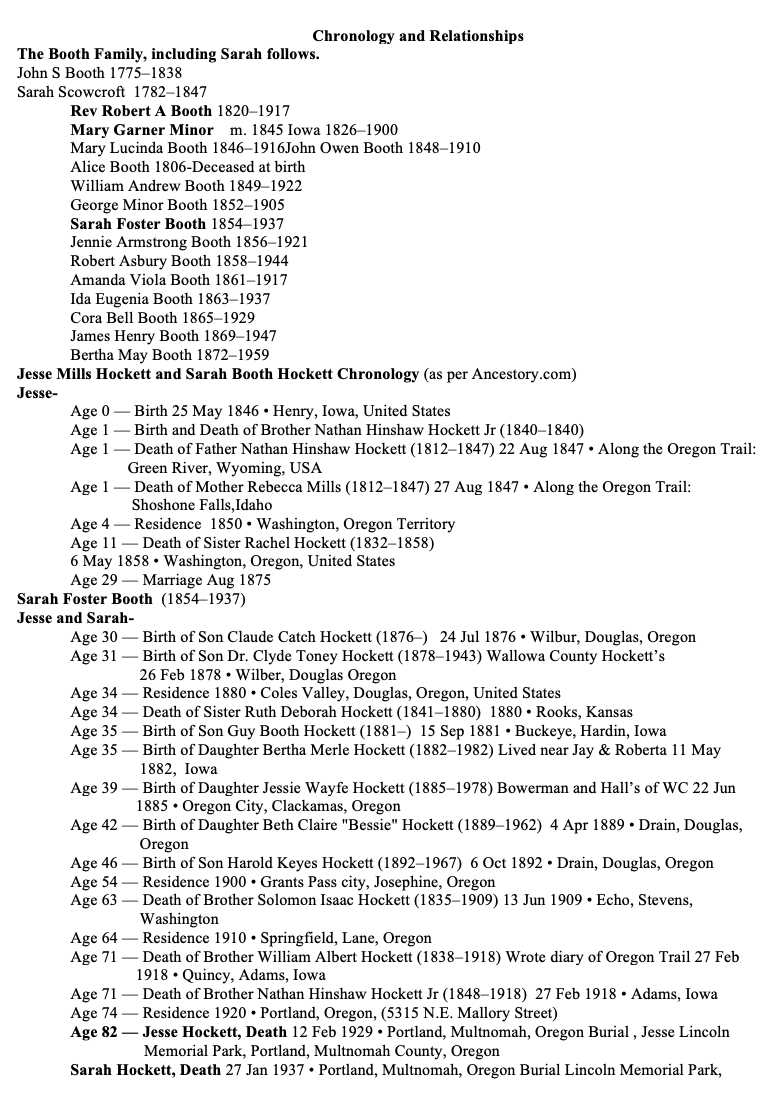The Lives of Jesse Mills Hockett, Sarah Foster Booth Hockett, and Rachel Hockett
Forward by R. Hockett
I have tried to research the lives of both women and men equally. However, historically, women were seldom reported on by their own names (if reported at all). Usually it is Mrs. “Man’s Last Name”. So unfortunately we are missing the details about the lives of the pioneer women, and so the history ends up being one sided. Another concept to remember is that this was a very exciting, adventurous time in the Northwest. When these pioneers are older and writing their memories in the 20th Century you can sense the enduring excitement they felt living in that time. We need to remember that these pioneers went from rudimentary log cabin living and riding horses to electrified houses and automobiles.The constant change was breathtaking.
The Lives of Jesse Mills Hockett and Sarah Foster Booth Hockett
1846-1929 1854-1937
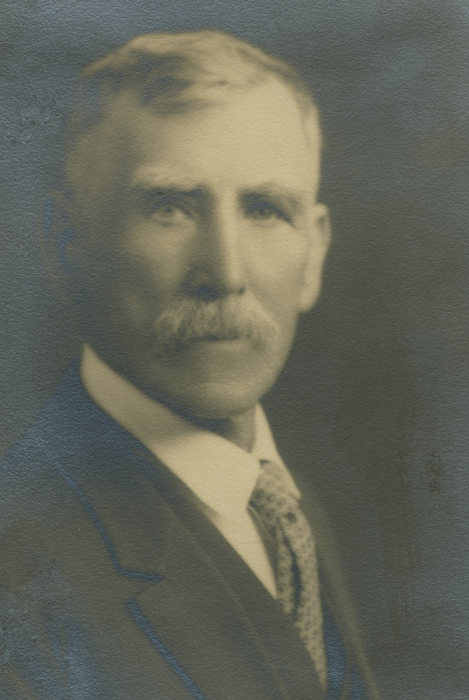
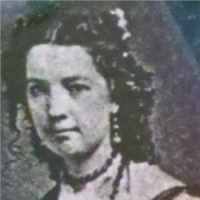
Narrative-
Jesse Hockett was born May 25, 1846 into a Quaker community in Salem Iowa, and a year later on April 10th 1847, baby Jesse and his family set off in two covered wagons, bound for the Oregon Territory. His parents Nathan Hockett and Rebecca Mills Hockett, had two wagons with horse teams, 1 or 2 saddle horses, plus 50 head of cows and heifers. Also in his family on the trip were his sister Rachel 16, brother Solomon 14, and brother William 9 (who as an adult wrote all this down). Baby sister Ruth was left behind in Salem (to be gotten later). Also Uncle Thomas Hockett accompanied the train for the adventure.
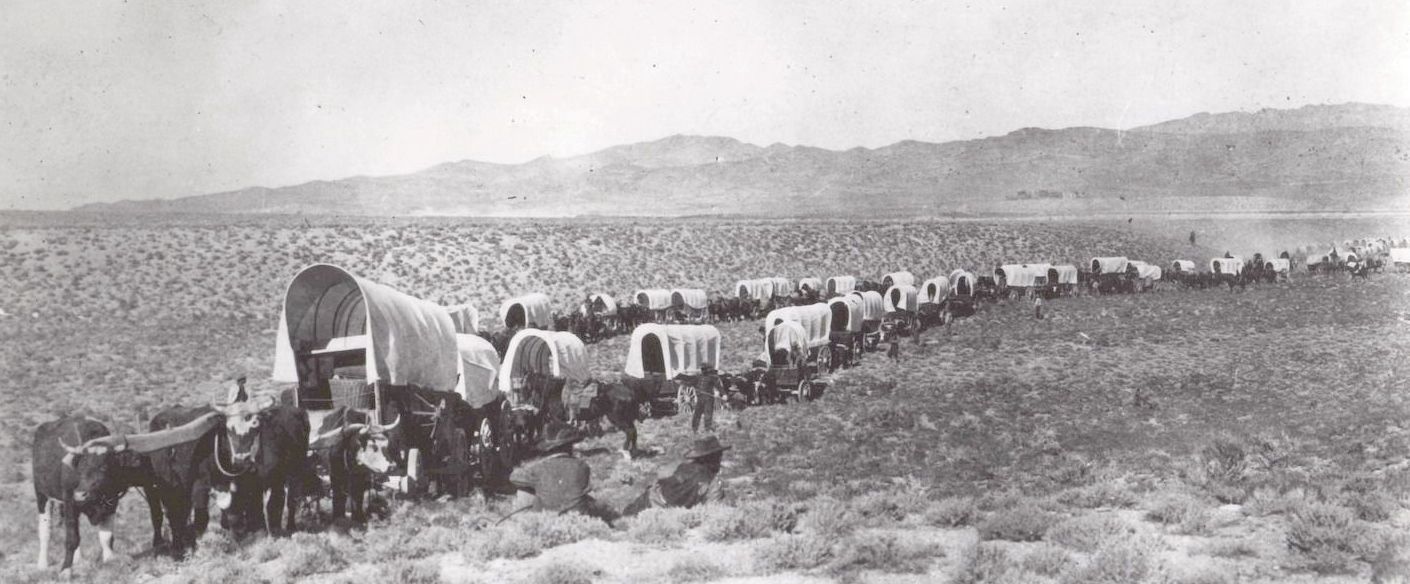
The entire group consisted of 7 wagons leaving Salem, intending to join other wagons in Independence, Mo. (The usual procedure). The entire diary of the trip is a well known record among Oregon Trail historians and is recommended reading. This narrative only covers important and interesting events. Also many researchers have fleshed out W.A. Hockett’s diary with notes from other Quaker travelers from Salem. A VCR video was also made (of which I have a copy).
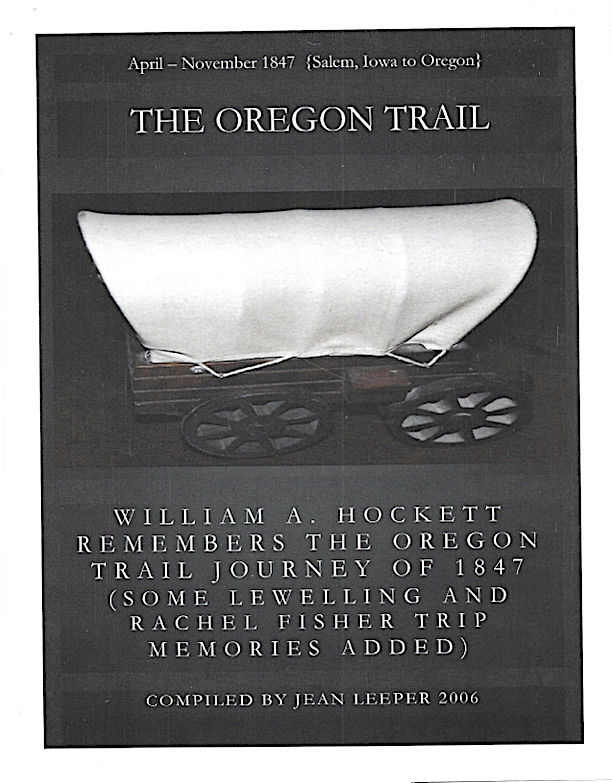
At one early point on the trail, June 15th, the wagon train is raided by Pawnee Indians seeking the cattle; no one is killed but many cattle are taken by the raiding party. At this time the Pawnee and Sioux tribes were at war with each other and tension among the pioneers was high. Arriving at Fort Laramie on June 28th they witnessed 300 Pawnees celebrating a victory by dancing around fires inside the stockade with Sioux scalps on long poles. The Pawnee were known as fierce fighters.
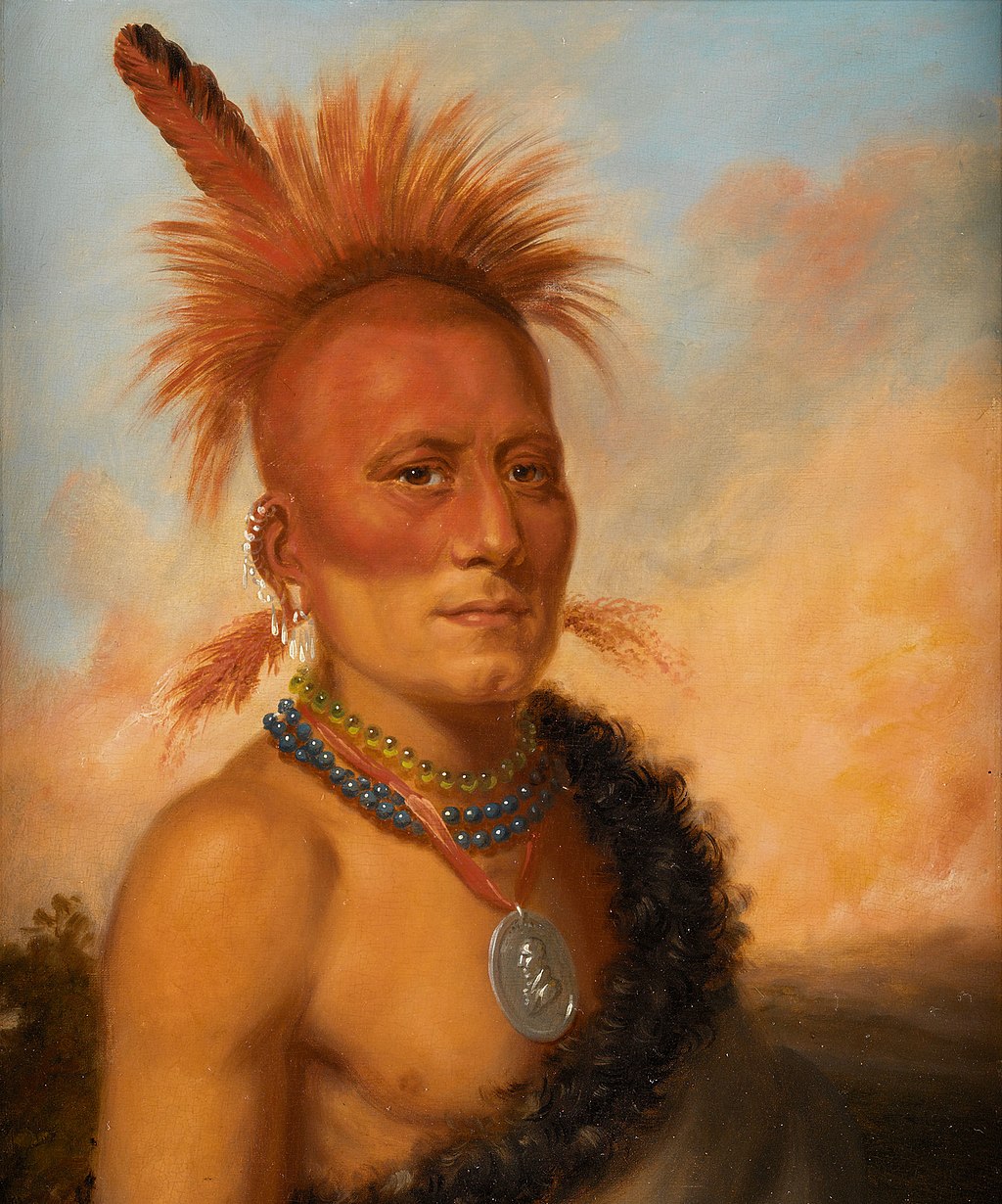
By July 16,1847 on the Sweetwater River, Wyoming, sickness hits the train and several members die. The wagons push on, and on August 22nd Jesse’s father Nathan dies near the Green River. On the night of August 27, his mother Rebecca also dies near Shoshone Falls. On August 28, after burial, the wagon train continued on.
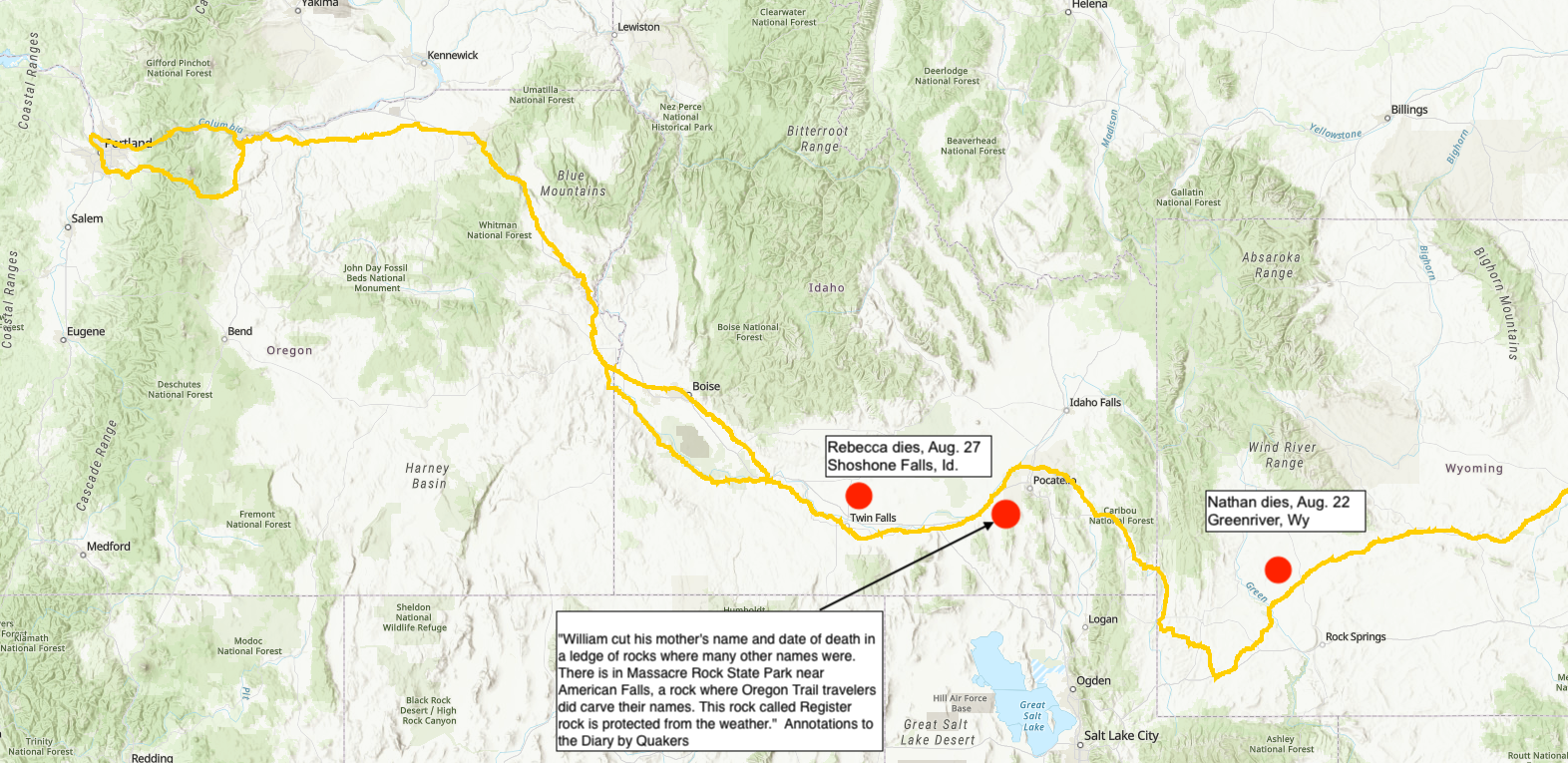
Note: When following modern maps and reading the diary you realize W.A. Hockett’s diary is not in sync as to events and locations in various places. Since he wrote this decades after the journey I guess that is to be expected.
The orphaned children proceed on with Uncle Thomas but everything is in such bad shape that by Walla Walla most of the cattle and the wagons are sold to Hudson Bay Company, one saddle horse and a few cows were kept. Uncle Thomas was somewhat of a free spirit (irresponsible?) and consequently was not interested in keeping the livestock since he did not intend to homestead, but to return to Iowa. I think this probably did not please Rachel.
With a few belongings and the animals, they load all onto a barge to float down the Columbia River to Celilo Falls near The Dallas, which required porting around the Falls.
W.A. Hockett-
“In October we came to the Falls with rushing water, whirl pools, and projecting boulders. It seemed there was not sufficient help to take boat around by land and it was decided to run the rapids as best they could which had often been done but not always successfully. So my uncle stayed in the boat with me but the rest of the emigrants walked the entire distance.
After the Falls was passed, I can’t remember anything else only how hungry I was and how my sister held me by the hands and how my little brother looked at me. But our boat was run down the mouth of the Willamette River where a towboat took us up to Portland where we arrived December 12, 1847, having been on the road since April 10, 1847, or eight months and two days from Salem.”
(Note: As a young boy with Dad in the mid 1950’s I saw Celilo Falls with the Indians fishing, before the dams flooded it).
Drawing of Columbia River Raft Pioneers Used

Celilo Falls Before The Dams
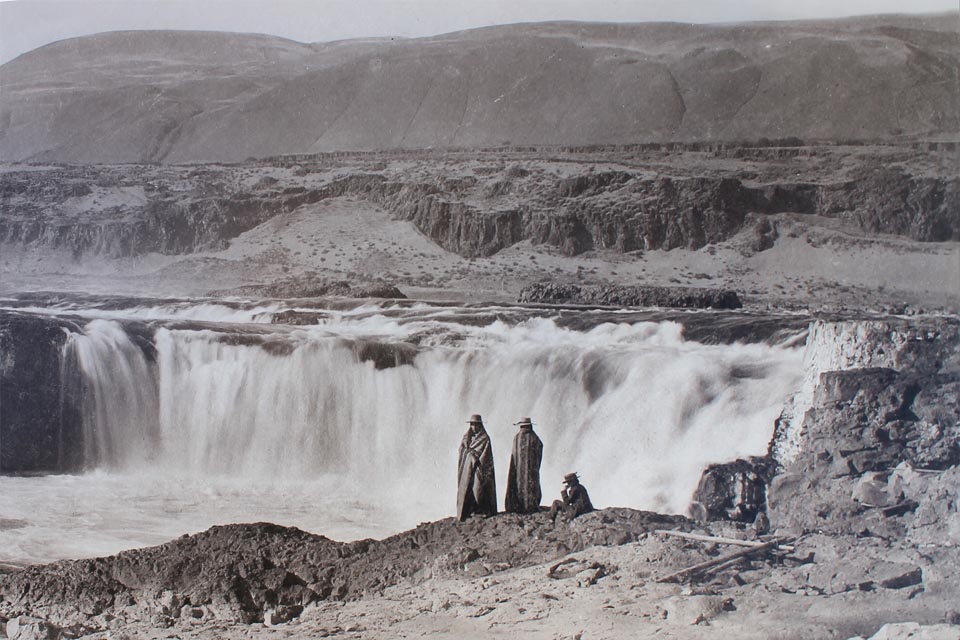
Now arriving in the Upper Willamette Valley, the critical issue was to find places for all the orphaned children to live for the winter.
From W.A. Hockett, regarding shelter provided for the children in Portland, 1847-48:
“An old hunter and trapper by the name of Squire Eberts, who had an
Indian woman of the Blackfoot Tribe for a wife, gave free use of a log house of his to live in. His partner, Bil Wilkinson, lived near him. His wife was an Indian woman from the same tribe, and no one could have been more kind or more helpful to us than these rough men of the mountains.”
Complicating their arrival without parents was an Indian War that commenced at the same time. The Cayuse Indians near Walla Walla had experienced many deaths from disease (measles) brought by settlers. All the white children recovered and half the Indian children died while in the care of the Whitmans. In anger a small group of Cayuse killed the Whitmans at the Walla Walla mission, which caused the first Northwest Indian War. Five hundred volunteers left the Portland area to go east and fight the war. Jesse’s Uncle Thomas, Mr. Ebert, and Mr. Wilkinson all left for the war leaving the children alone, much to William’s anguish, feeling abandoned.
Note: There is a well written, extensive narrative from the point of view of the Cayuse that is very different from the history written by white people. Modern historians now know that the indigenous people of the Western Hemisphere numbered in the millions and 80% were killed by infectious diseases brought from Europe. The Cayuse at this time were being severely impacted by the new immigrants.The West was not an “empty” paradise to be taken for free.
Regardless of your point-of-view, the NW at this time is a place of fear and violence on both sides. Below is a graphic depicting the killing of Marcus Whitman (white man’s perspective). One wonders if he was really reading the Bible with all the shouting?
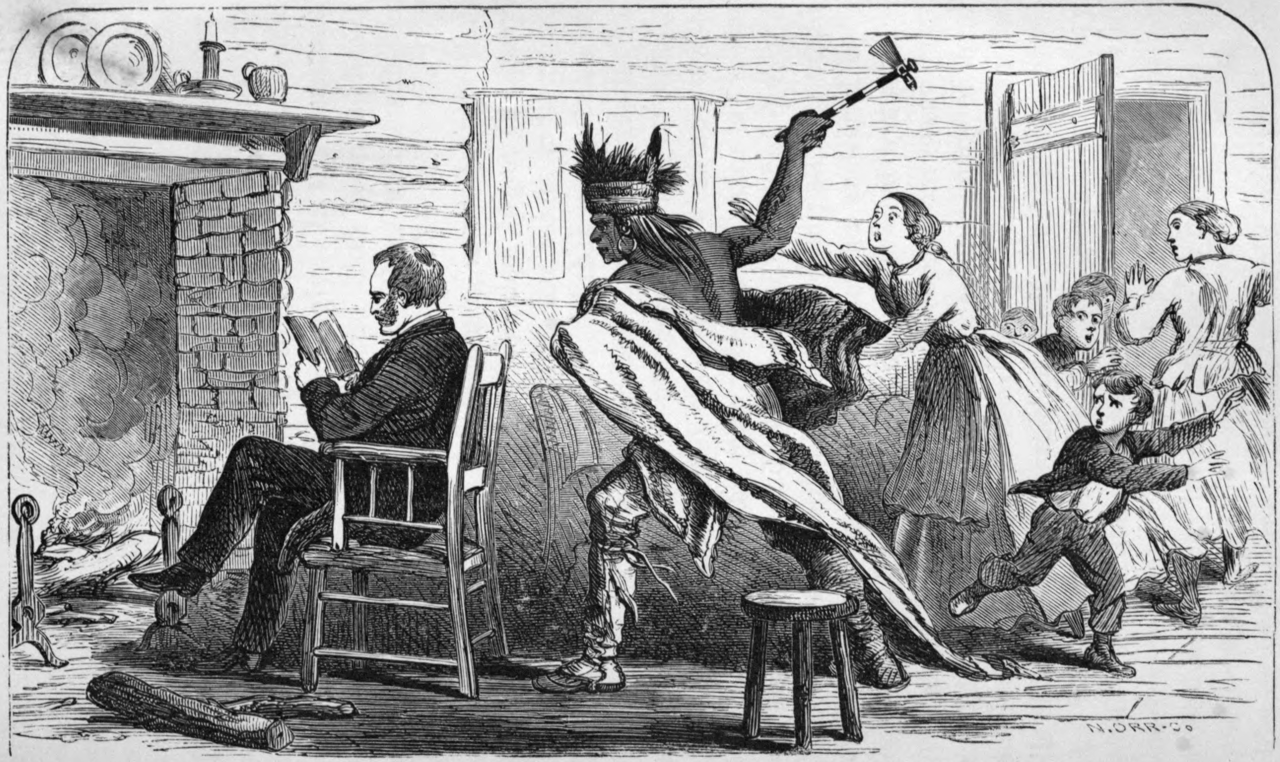
After Uncle Thomas leaves, an administrator was appointed for the children. The administrator took all their family possessions and sold them (Rachel bought back the family bible). However, “Resourceful Rachel” had hidden $1,200 in gold and later gave back a share to her brothers when they became of age. Now big sister Rachel was their guardian at 15 years of age. She found a home for William with Jacob Reed, a nice man. She found Solomon a home with a man by the name of Magee, and she kept Jesse with herself. From here the children scattered to California (the Gold Rush) and then back to Oregon by 1850.
In 1847 Portland was just a string of shacks along the Willamette River but growing fast. It became the fastest growing city in the West for a time. Oregon City, 1845, below.

Rachel Hockett Griffith-
As pointed out, Rachel insisted on keeping Jesse with herself. By 1849 Rachel had found a husband by the name of John S. Griffith (1825-1866) and married him. They went to California, he to speculate in the gold fields and Rachel to run a boarding house. They had four children (and many grandchildren). There are notices in the local Portland newspapers in 1852 that John Griffith had letters at the post office to be picked up, and one posting that he found a mule someone had lost.
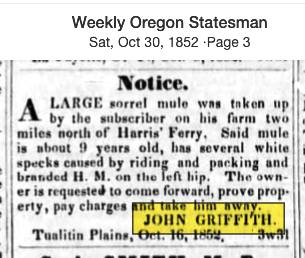
We have to assume Rachel is also there at that time. Rachel and John Griffith filed for a land claim in the 1850’s which was formalized in the record books in 1873 (after both were deceased). The land is approximately 630 acres (they added to the claim) in what was then called the Tualatin Valley. The land is only 7.5 miles from current downtown Beaverton.
Griffith Land Patent Map
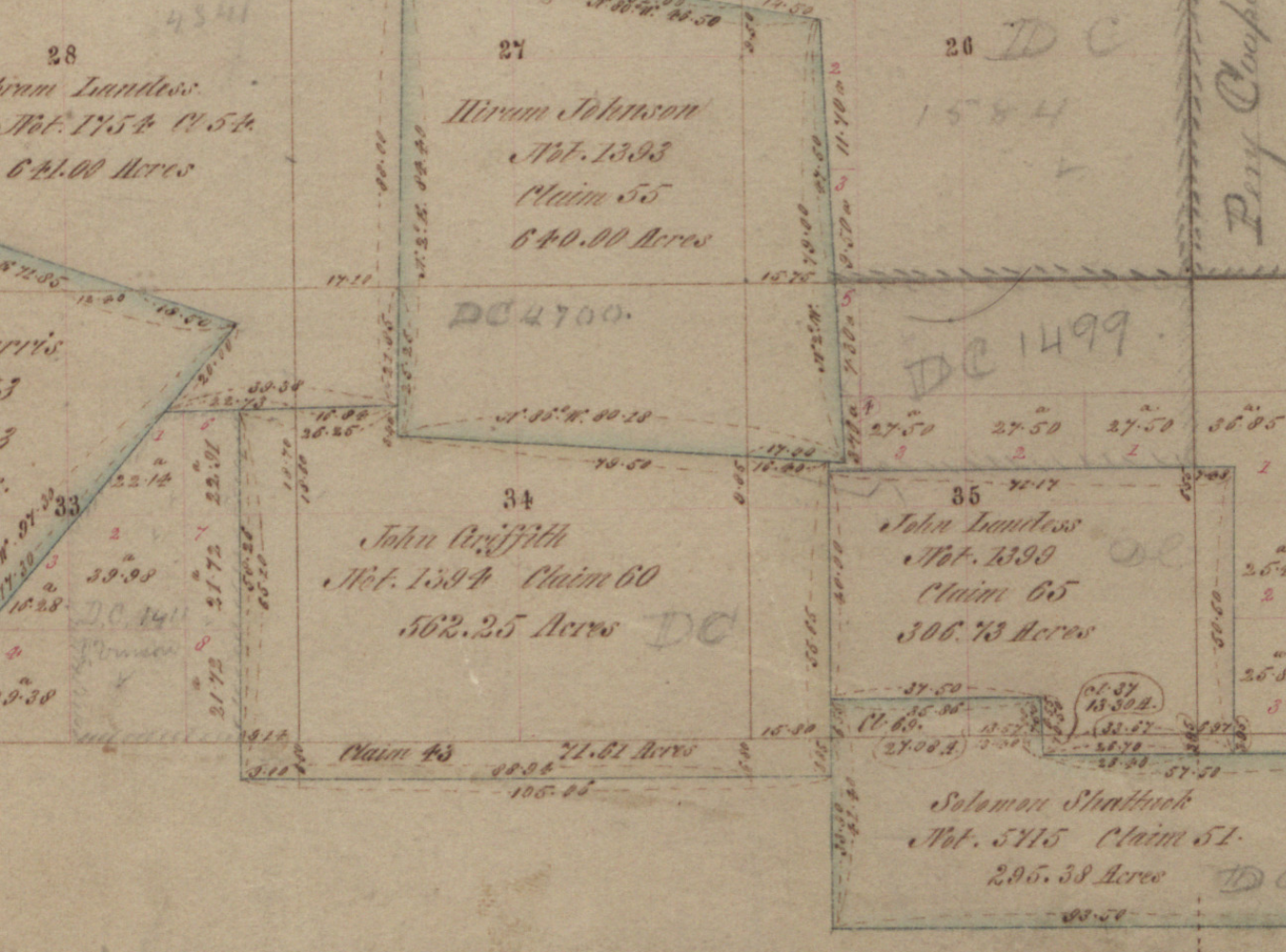
BLM Patent Record For Griffith Property (the small squares are the sections involved)
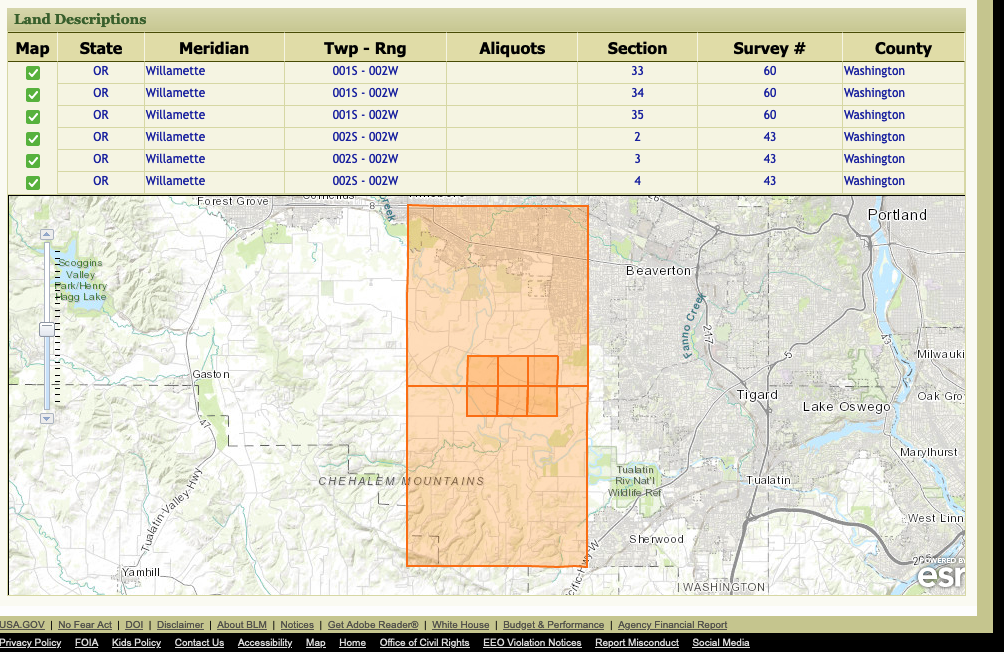
Google Map of Griffith Property Location

Land Patent Document, 1873, Establishing Rachel and John’s legal claim

Rachel and John had several children whose heirs are present today. The children were Christopher 1849-1858, Jesse 1852-1942, William 1853-1853, Nancy 1856-?, and Emma ??.
Here is the 1942 death certificate for Rachel’s son Jesse Griffith, named after his Uncle Jesse.
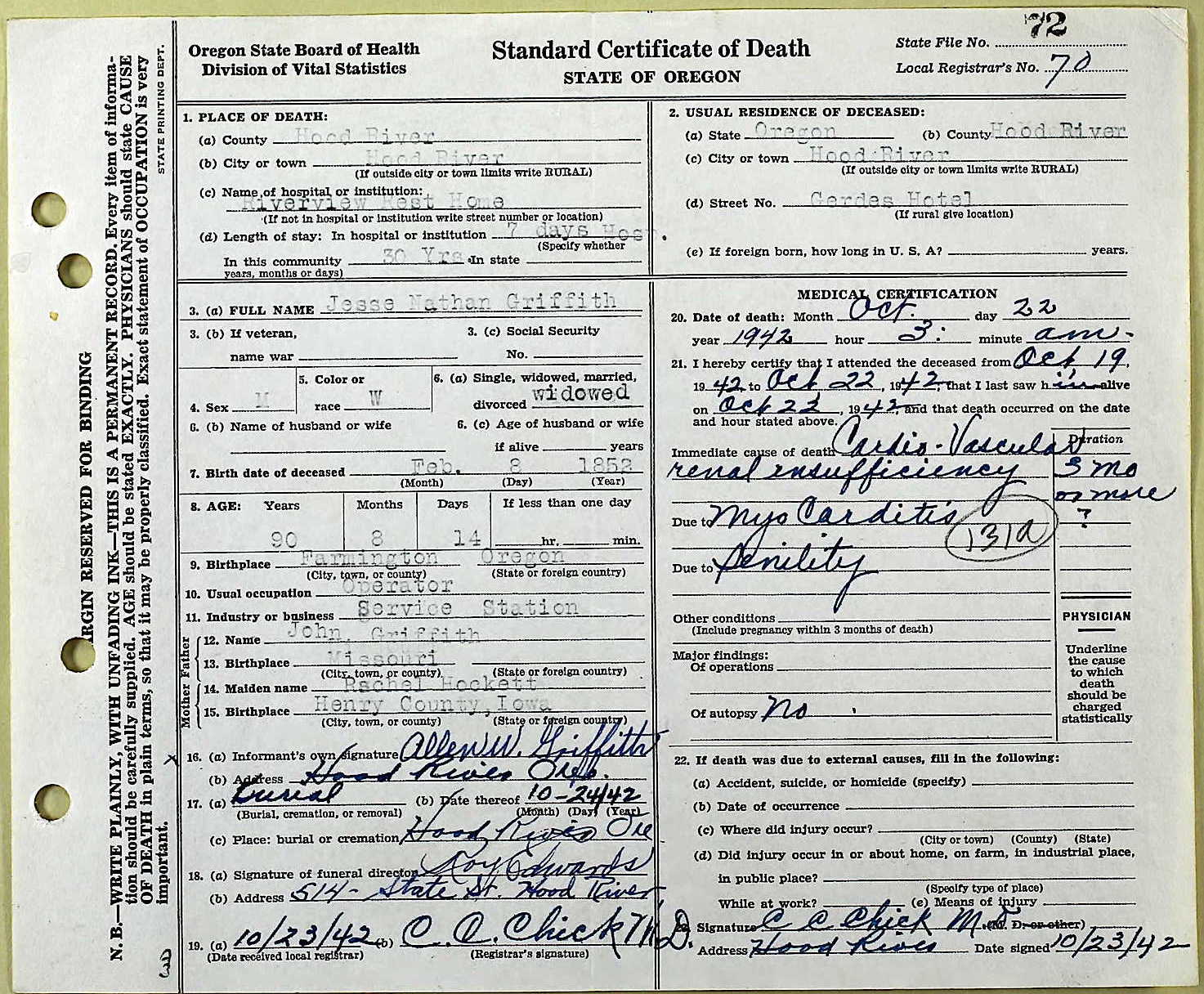
Rachel refused to return to Iowa with her Uncle Thomas via ship to Panama, (why go back to flat, civilized, boring Iowa?) and she also refused to let young Jesse leave her side. Rachel appears to have been a very independent, strong willed young woman given the circumstances. Jesse and the rest of us owe much to Rachel. These early pioneers were very much committed to living in the Oregon Territory of the mid 19th Century (apologies to the Native Americans who lived there for thousands of years).
Rachel died in 1858; John died around 1866. There does not appear to be a grave site online. So many children died in this era it is hard to nail down exact names and numbers since deaths at birth are frequently omitted.
Sarah Foster Booth and The Yamhill Period-
Sarah (or Aunt Seddie as children called her later) was born in 1854 to Mary and Robert Booth just one year after the Booth’s crossed on the Oregon trail in 1852-53. Sarah was the fifth child; four children were born before the Oregon Trail journey. Ultimately there were twelve children in the family. For a time the Booth’s lived in what is now Yamhill County, where, Sarah in a memoire, recounted tales of clashes with the local Indians.
“Father was gone on his preaching trips most of the time, so Mother had to oversee the boys, who did the work of the farm. One of the Indian boys, named Moses, who was about 16 years old, became very fond of my brothers. He would often visit at our home. One day he came running to the house and said, “Go quick. Some bad Indians coming to burn your home and kill you. I will have to run back or they’ll kill me for telling.” We hurried away from home and stayed at a neighbor’s house that night. Next morning there were the moccasin tracks of Indians all around our house, but they did not burn the house.”
Sarah also recounted that Lt. Phil Sheridan often visited the house. Sheridan became one of three principle Union generals in the Civil War (Grant, Sherman, and Sheridan) and was instrumental in defeating Lee. Here is Sarah’s account:
“Phil Sheridan, one of the officers at Fort Yamhill, used to like to come over to our house to eat Mother’s home cooking. He often ate Sunday dinner at our home. In fact, most of the officers who were stationed at Fort Yarnhill prior to the Civil War used to be frequent visitors at our home .”
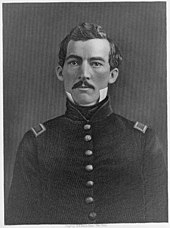
Here is another Yamhill story from a relative about Sarah:
“The Indians used to try to buy Aunt Seddie from Grandma Booth because she had long golden hair. Because of this she never went far from the house alone. On one occasion a party of Indians on horseback saw her in a field and rode to cut her off from the house, she managed to beat them home, badly frightened for she was sure intended to kidnap her. “
Another memory recounted by Sarah on living in the Yamhill area:
“As I look back on my girlhood I realize how busy my mother was rearing her large family of children and doing all of the work of the home, for in those days there were no labor saving devices. Mother carded and spun the wool and made the clothes for all the children. She also made father’s overcoats, and made his white shirts. She did all of the sewing by hand and at first did the cooking over the fireplace. She molded all the candles we used, and knitted socks and stockings for all of us and also knitted socks for sale. Mother knitted lots of socks and mittens which she sent to her brother John, who was a soldier in the Union Army. He was wounded twice. When he was finally discharged, he told mother that he had never received a single pair cf the socks or mittens. “
Jesse and Sarah, Early Years –
After Rachel died, Jesse was “bound over” to a man named Bronson in the Portland area. He lived with Bronson until the age of 19 when he left to work and attend Wilbur Academy, a Methodist school, in Wilbur, Oregon (Douglas County). The school was founded in 1857, so it was about 8-9 years old when Jesse attended there in 1865-66. Both Jesse and Sarah received education at the Wilbur Academy and they both taught at the school. So it is likely that they met at the school.
First Wilbur Academy building:
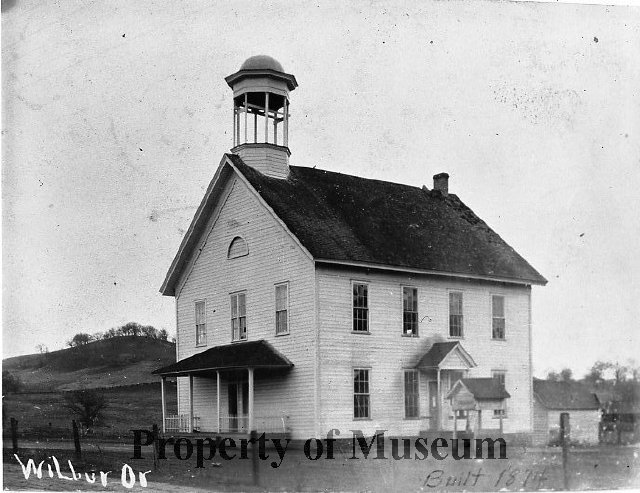
A few years later Jesse attended early Willamette University, taking instruction in the brand new Waller Hall, completed in 1867.
Waller Hall-
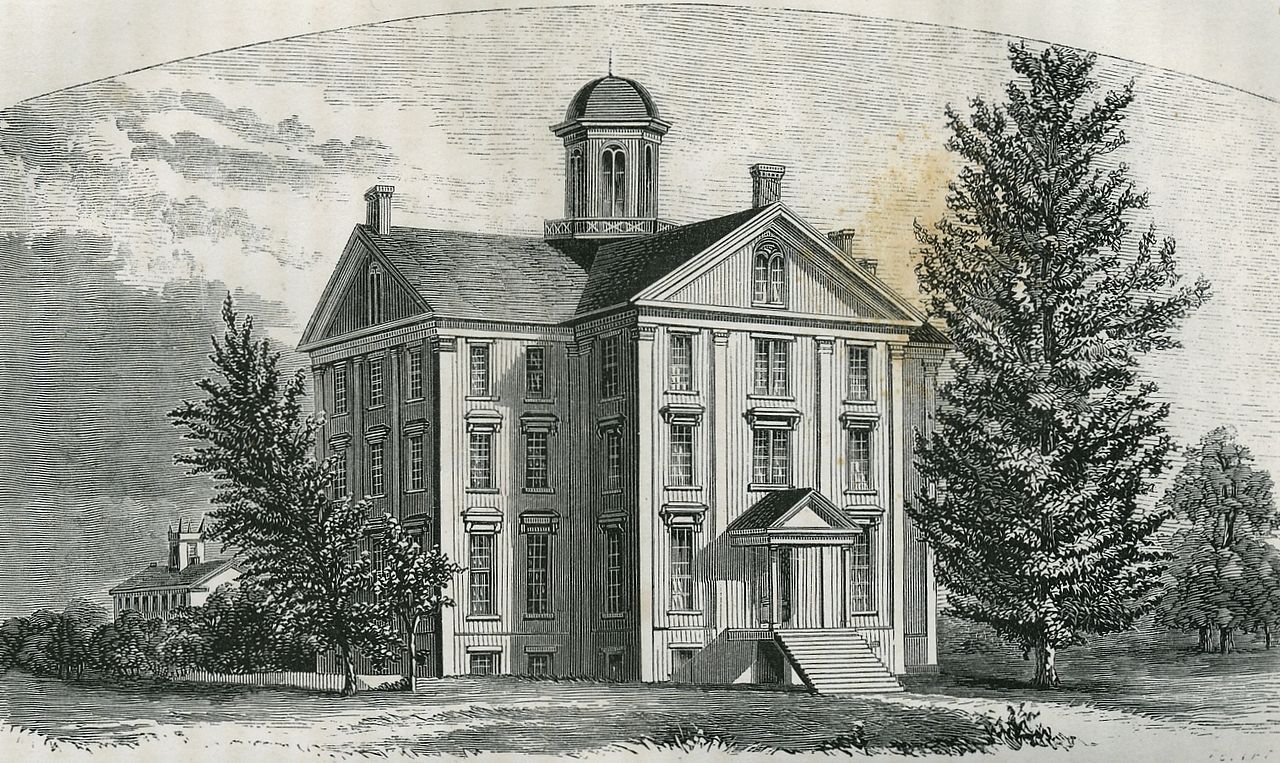
Sarah’s father, Robert A. Booth, became a pastor in Wilbur in 1867 and later farmed there too. He later became one of the famous Circuit Riders preaching at multiple churches in the Willamette Valley, of which his likeness is on a statue on the Oregon Capital lawn.
The Circuit Rider, Oregon Capital Lawn, Robert Booth subject-
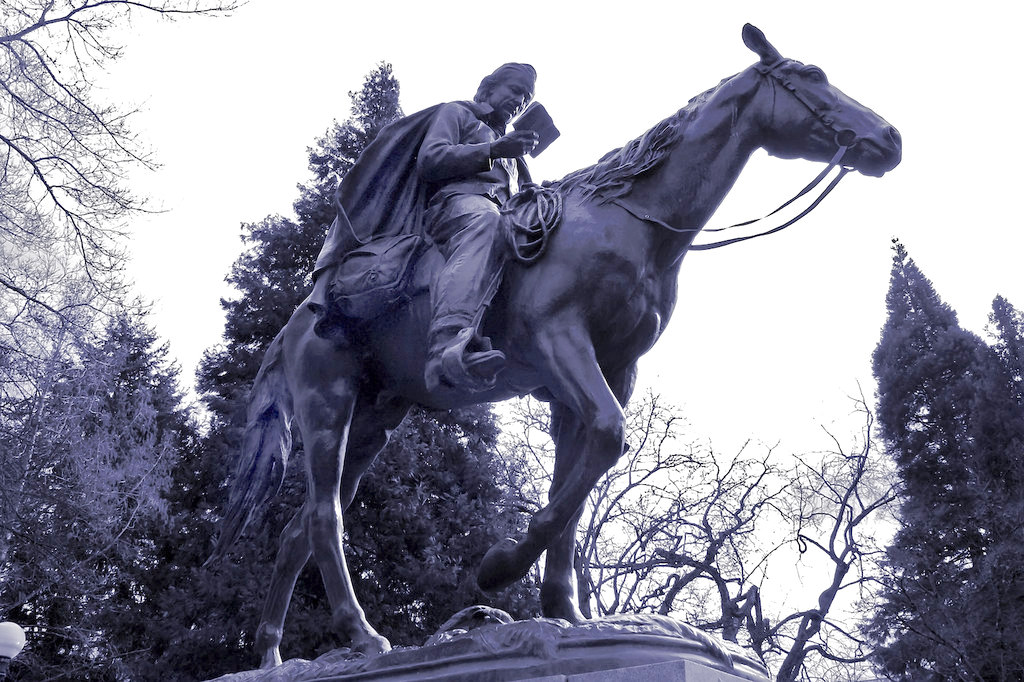
Jesse and Sarah As Adults-
For a period in their early 20’s Sarah and Jesse both taught school at the Wilbur Academy and Jesse became it’s principle. Sarah taught five years. They probably met there at the school.
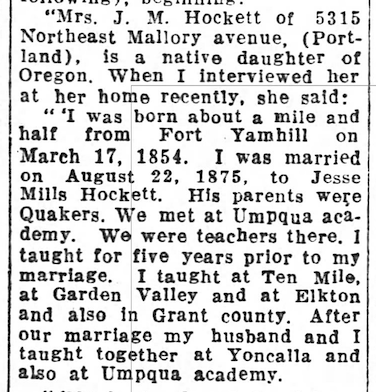
They were married August 22, 1875 in Douglas, County, Oregon. Jesse was 29 years old and Sarah was 21 years old.
Marriage Certificate-
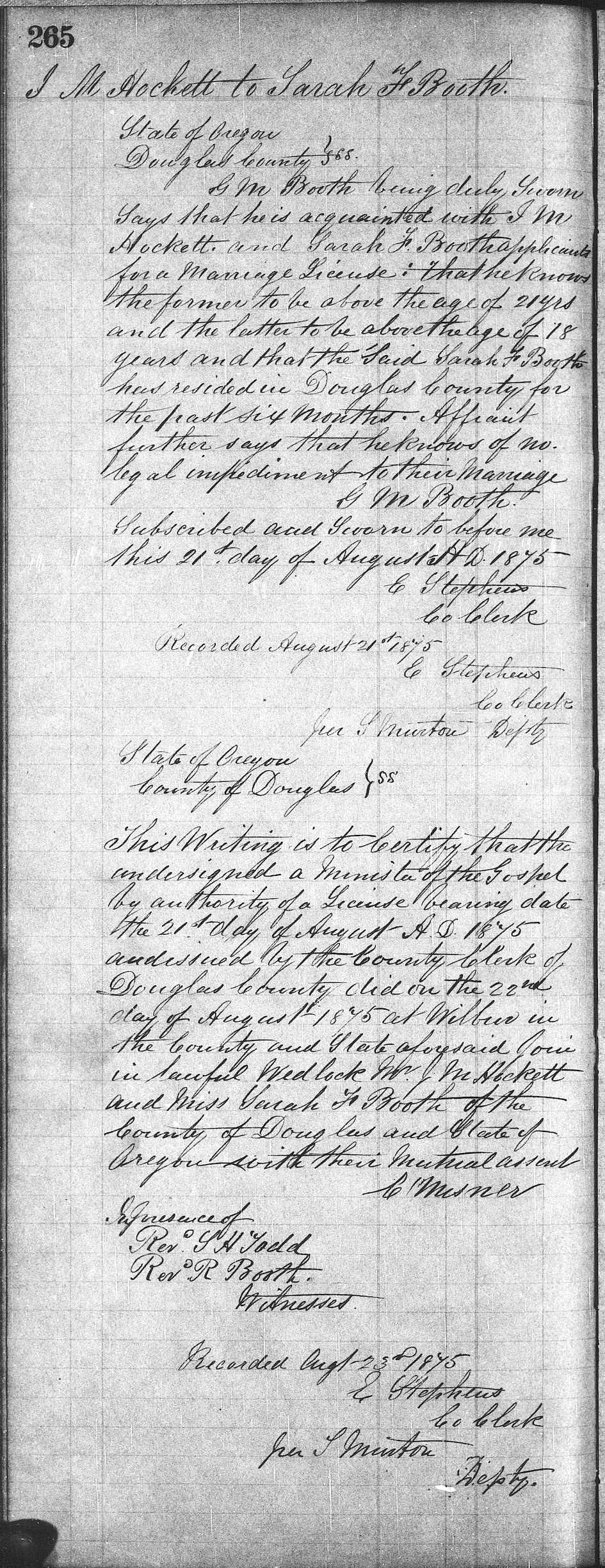
Their first child (of seven), Claude, was born in 1876, followed by Clyde 1878, Guy 1881, Bertha (Merle) 1882, Jessie (Wayfe) 1885, Claire (Bessie) 1889, and Harold 1892.
Jesse taught ten years (at either Wilbur or Willamette) before both moved onto a farm in Douglas County.
Douglas County Land Assessment, 1874
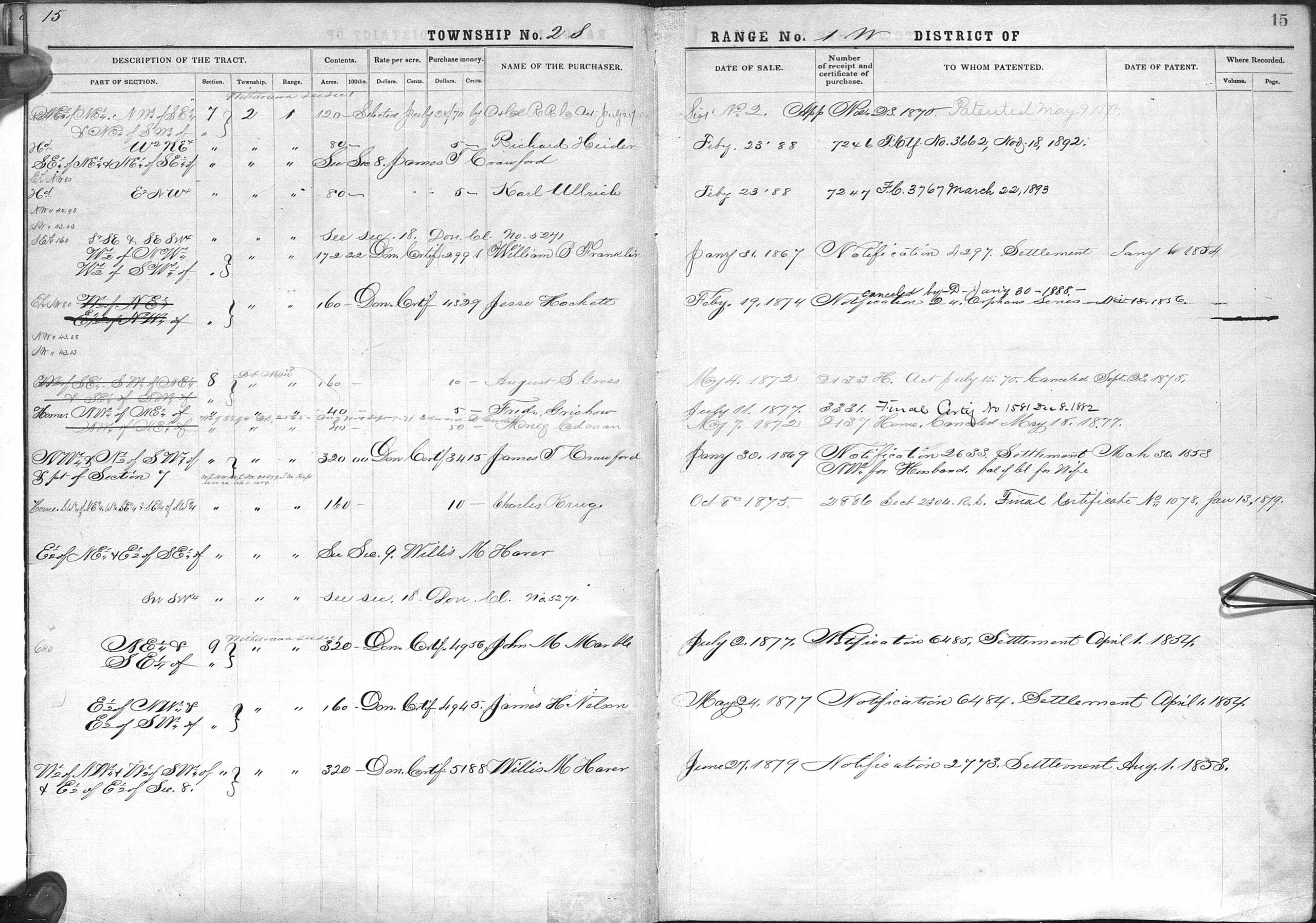
Assessment Detail

Their farm is listed on the Douglas County list of historical places. It is technically within the city of Yoncalla.
Barn description:
“Sawn post and beams; mortise, tenon. STRUCTURAL FRAME: Wood and pegged: 1″ X 6″ ship lap on north elevation and 1″ X 10″ vertical board on south, east, and west elevations. The Jesse Hockett Barn is one of the few barns built in Douglas County with the mortise and tenon technique. Stone Piers Foundation.”
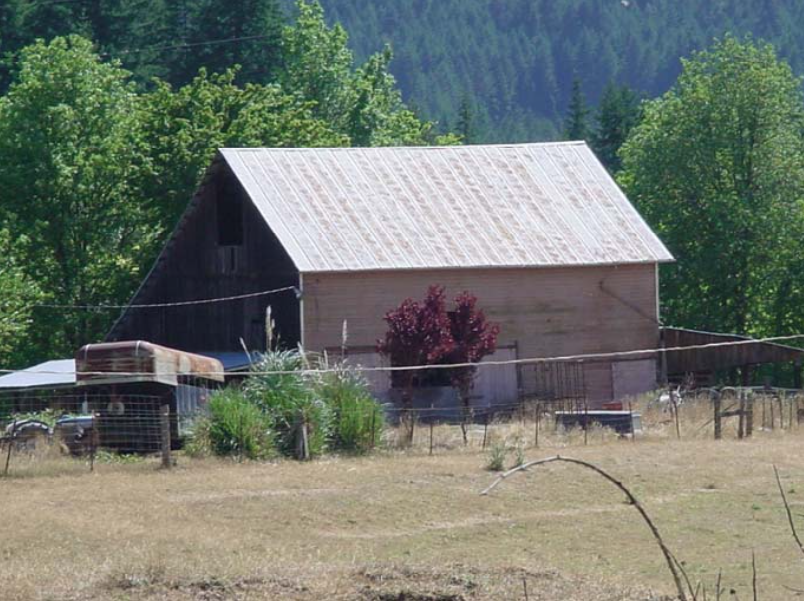
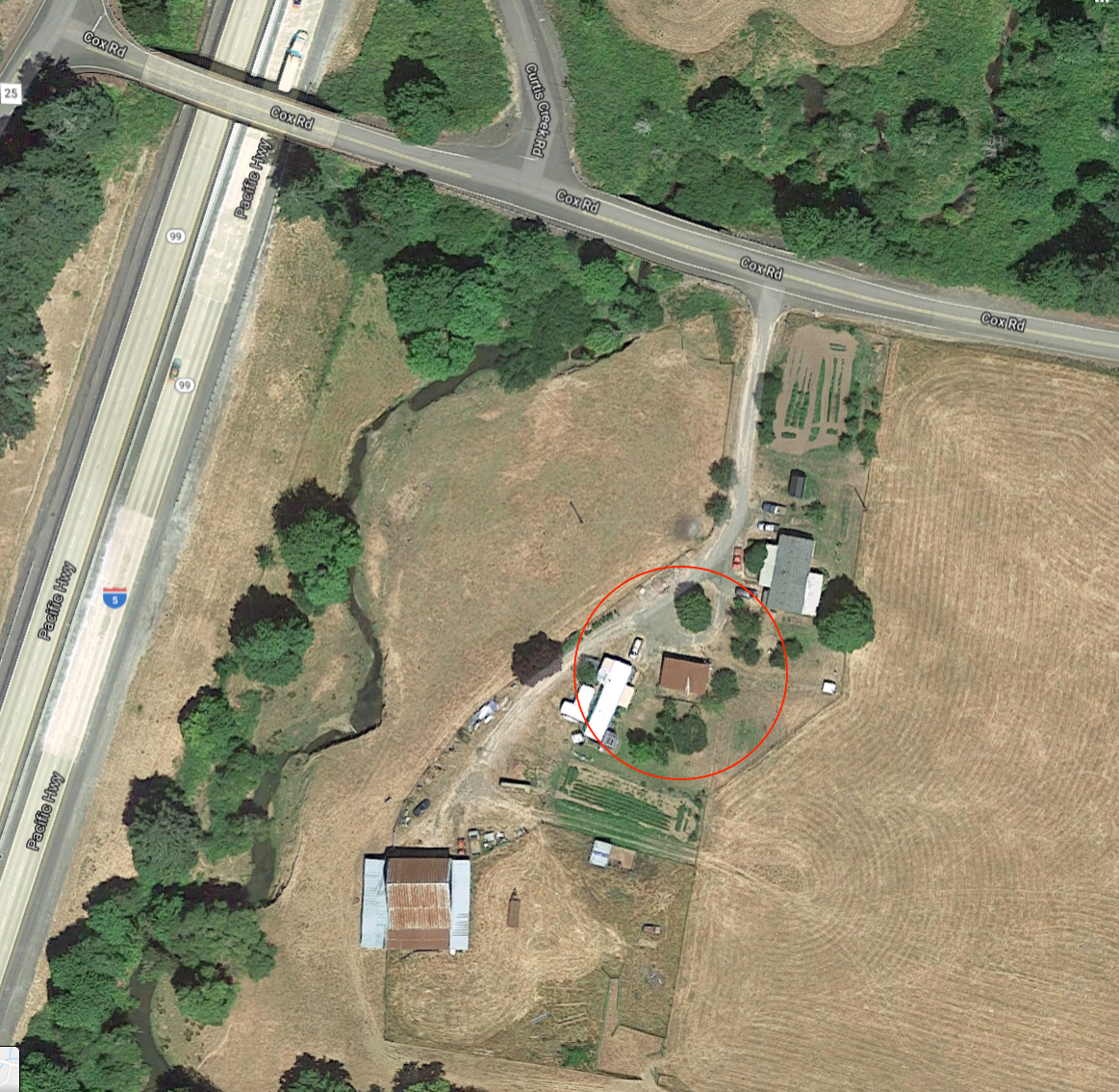
Douglas County Historical Record of Hockett Barn
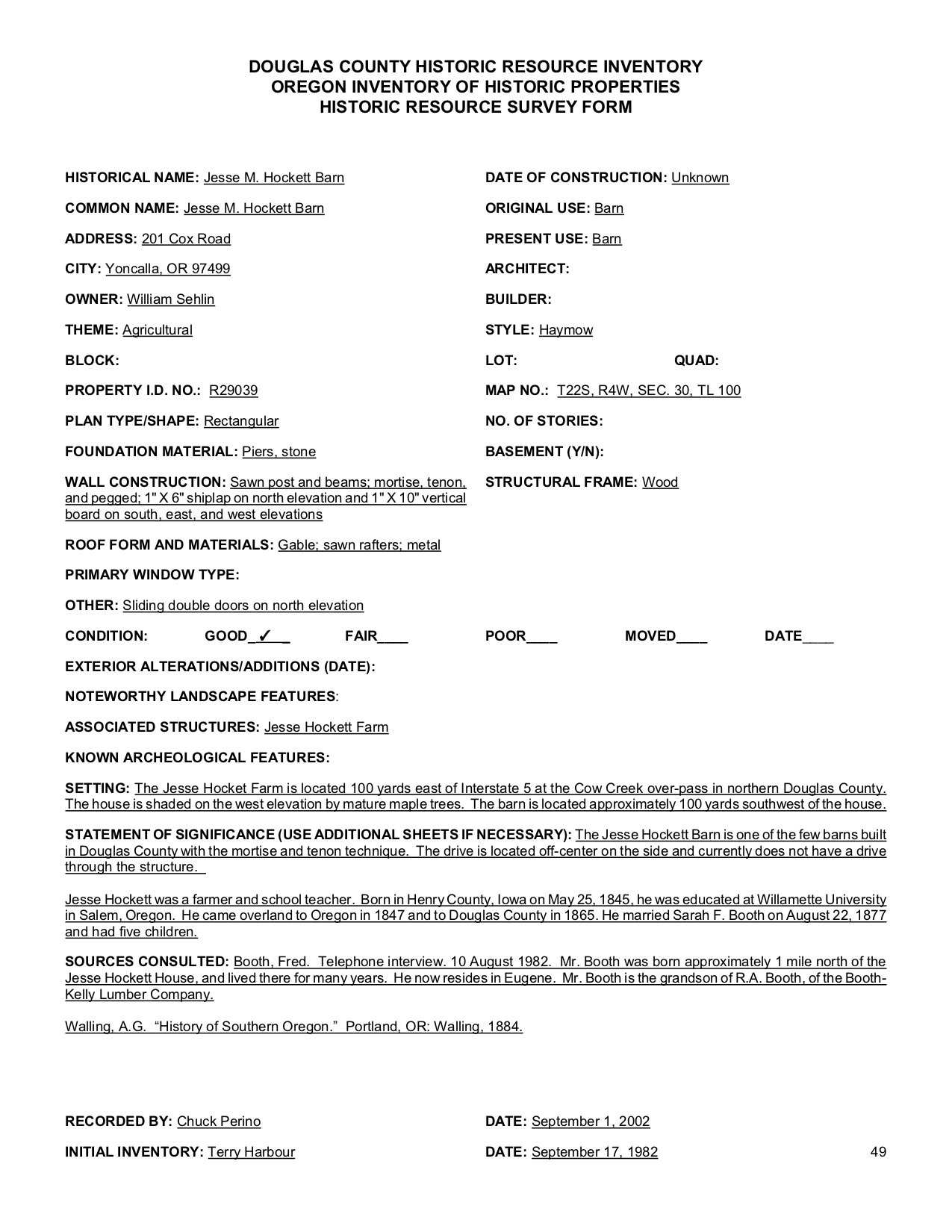
At some point the barn property is transferred to ownership by someone else yet to be determined.
The record is unclear about living for 20 years in Ashland and Grants Pass, but it seems they lived for a total of 40 years in Southern Oregon, either Douglas County or Grants Pass.
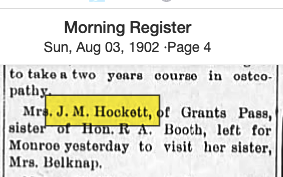
While Jesse and Sarah are living in Grants Pass or Douglas County, second son Clyde T. Hockett is sent overseas to fight in the Spanish American War of 1898 in The Philippines. There are a series of letters from Clyde back to the family about the war. Here are two copies of letters from his father, Jesse, to their son (Sarah also wrote letters, which are not available). There are some obvious transcription errors in the grammar. Grand Pa is John Booth, Sarah’s older brother who lived in Grants Pass. The letter gives a nice glimpse into the character of Jesse as a father and person.
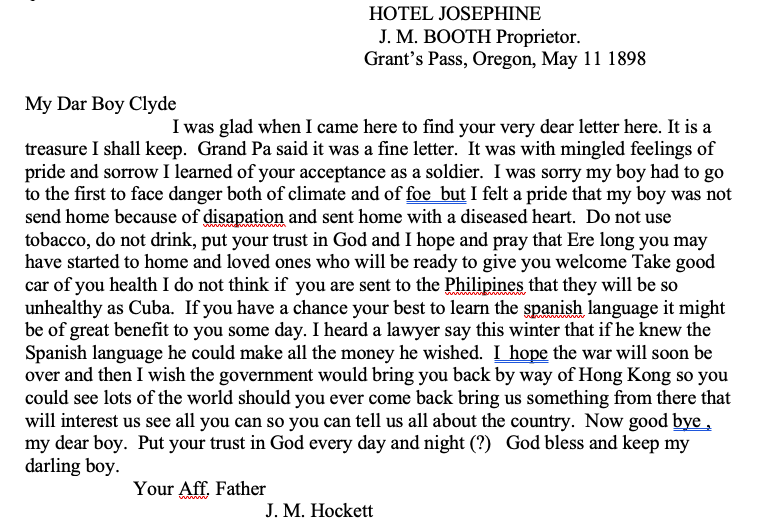
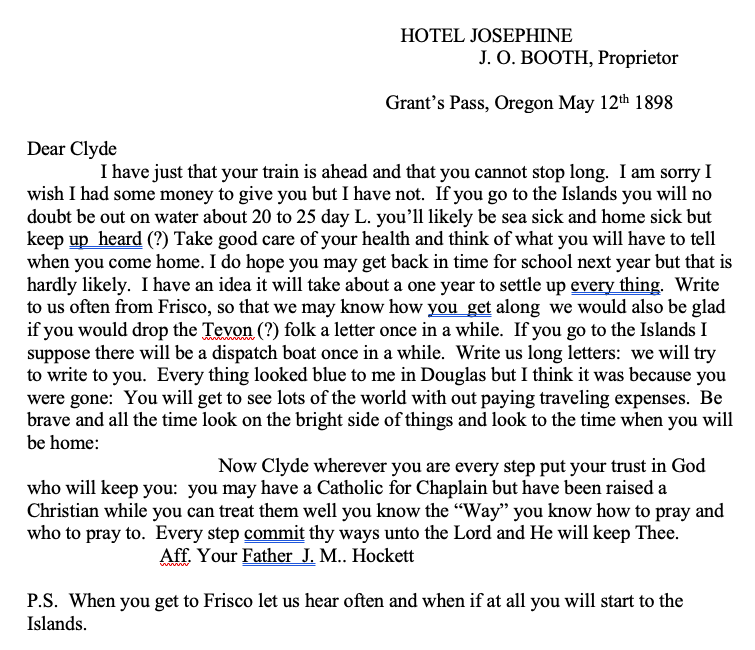
Clyde Hockett became seriously ill in the Philippines from disease but recovered and returned safely home. He was also in several fire fights.
Eugene Residence Period-
At some point Jesse and Sarah move to a new home at the end of Deadmond Ferry Road on the McKenzie River at the outskirts of Eugene (now close to downtown Eugene). This happens around 1910 and lasts until 1917 when they move to Portland.
Deadmond Ferry Road end at the McKenzie River, near Eugene
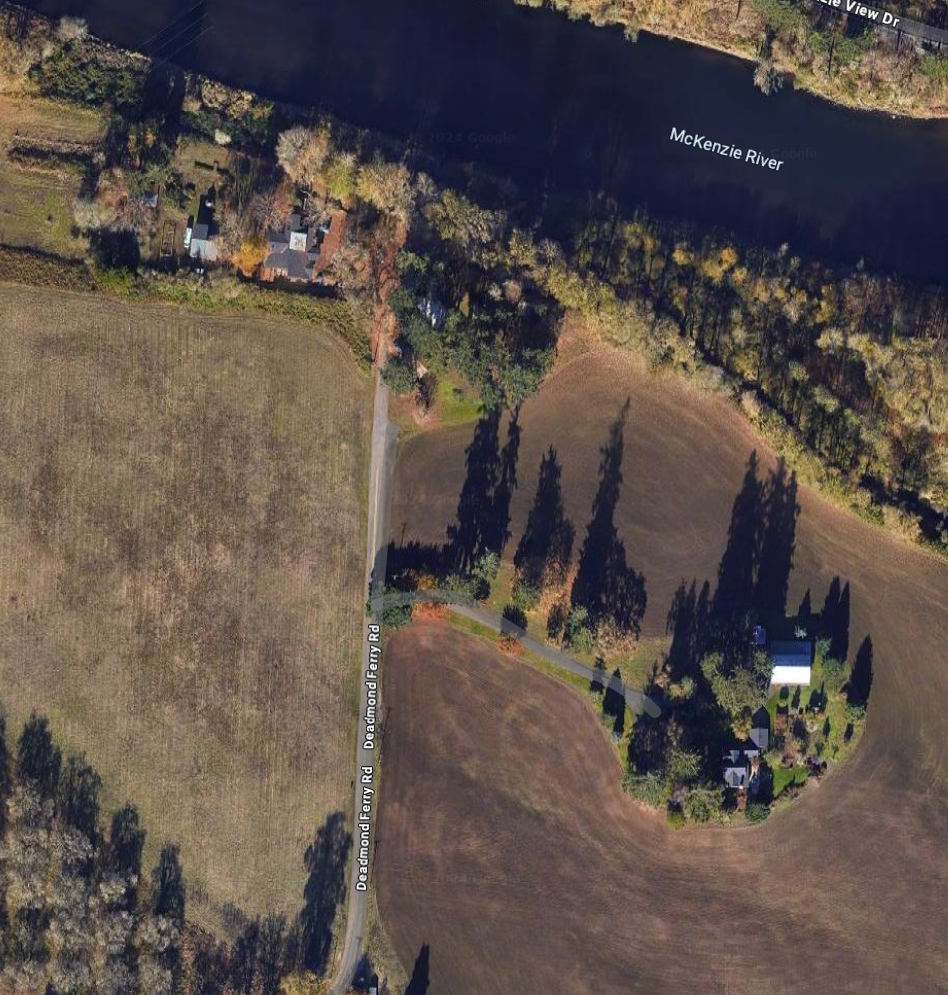
During this time the Eugene newspapers are full of gossip tidbits about Sarah and Jesse visiting back and forth between their numerous Hockett and Booth siblings and children in Portland, Salem, Eugene, and Southern Oregon. This probably occurred by train since at that time rail lines were all over the place (before paved highways were built). It is surprising the number of times Sarah is mentioned as visiting in another city. Not a stay-at-home person at all. Did she take all those children with her?
Oregon Passenger Train, Early 20th Century
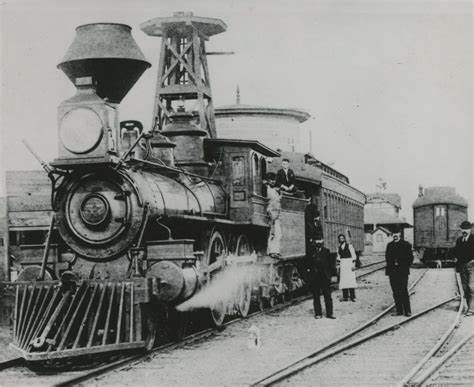
Passenger Rail Lines, Western Oregon, Early 20th Century
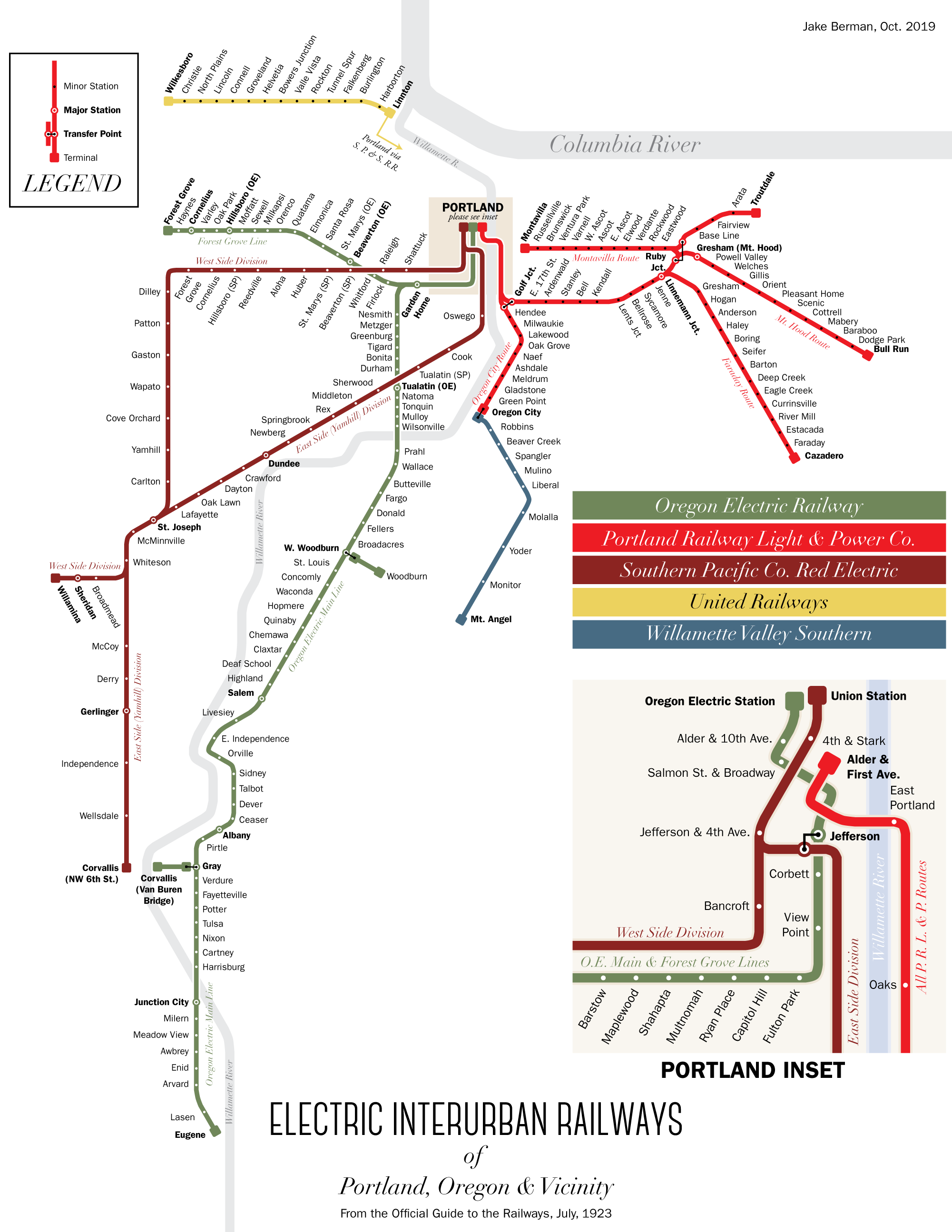
By now we know the research indicates that Jesse and Sarah were a very active couple, participating in many activities where they lived. Jesse gets in a debate in the local paper about where to locate the Douglas County Poor Farm (for indigent people to live); he participates in public debates, runs for County Treasurer, attends reunions, and many other public activities.
Jesse in a 1920 Reenactment of Wilbur Academy Play

Here is a comment about the personalities of Jesse and Sarah which cuts through the dry statistics of their lives:
“As I look look back to those days, I realize that Aunt Seddie and Uncle Jesse were a very happy and devoted couple, loyal to each other, their children, and their friends, and kind to everyone. They were unusually keen-minded and intelligent, traits which are reflected in the fine record made by their children and grand children.”
It is also noteworthy that when Sarah sold furniture before the move to Portland, one of the items was a piano. So we know music was important to them. Their’s was a house full of culture.
Sarah Posts Ad To Sell Household Items and Move To Portland

‘
Portland Residence Period-
In 1917 they move to Portland and start living at 5315 NE Mallory in Portland, their final home. N.E. Portland is well known to many Hockett’s: Jay and Roberta Lived nearby and Jay taught high school English at Grant High. Great Aunt Fay Wade Riley lived nearby (her husband Earl was Portland mayor). Cousin Wade and Isabel’s house is not far away. Uncle Vernon and Aunt Maxine Long, lived close by, and many others including Roger and Wendy in the 70’s and 80’s.
Home at 5315 NE Mallory in Portland
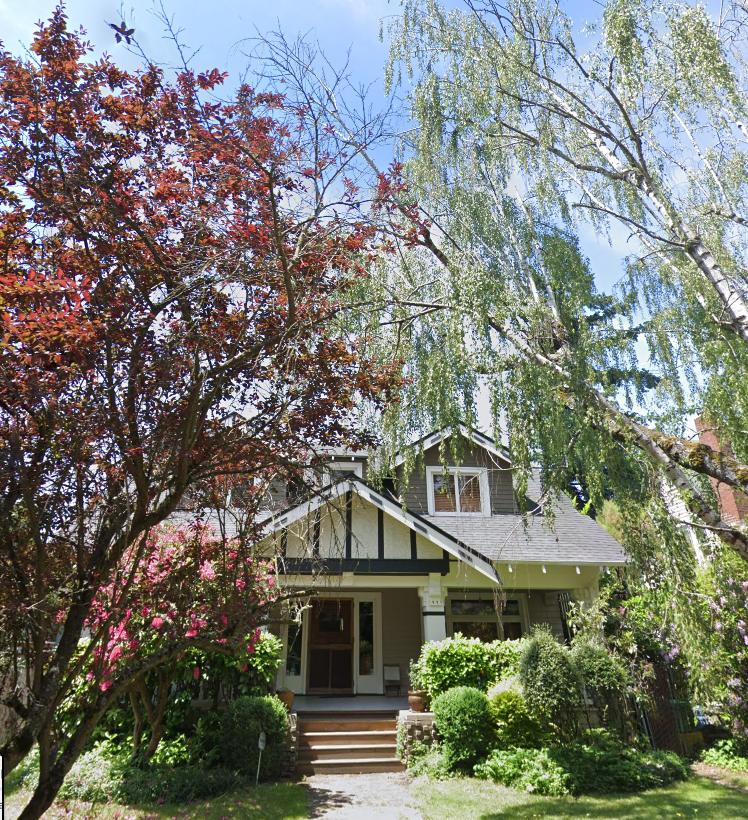
In 1925 while living in Portland, Sarah and Jesse celebrate their 50th wedding anniversary.
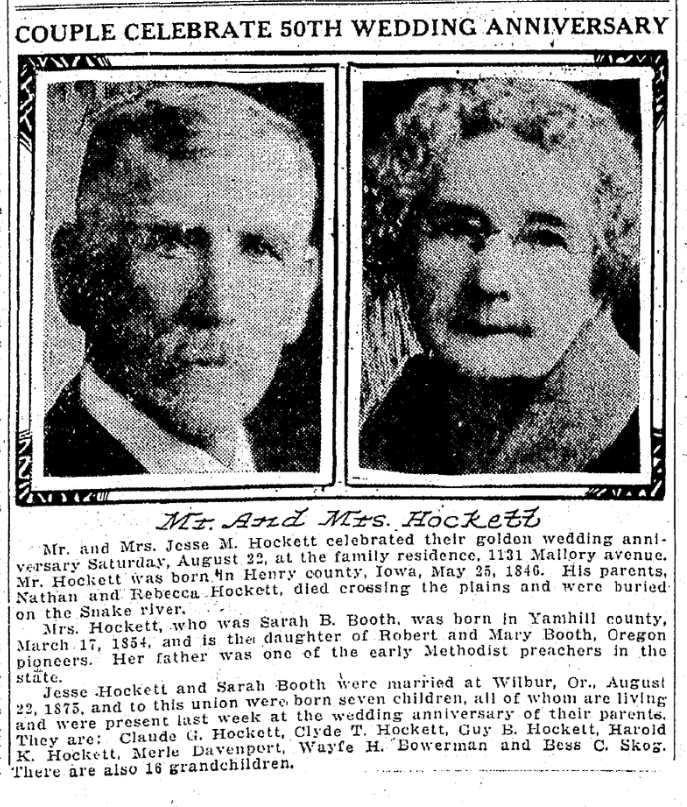
All good things must come to an end and on Feb. 12, 1929 Jesse passes away in Portland.
First Part of a Long Obit in The Portland Oregonian

In 1937 Sarah also passes away.
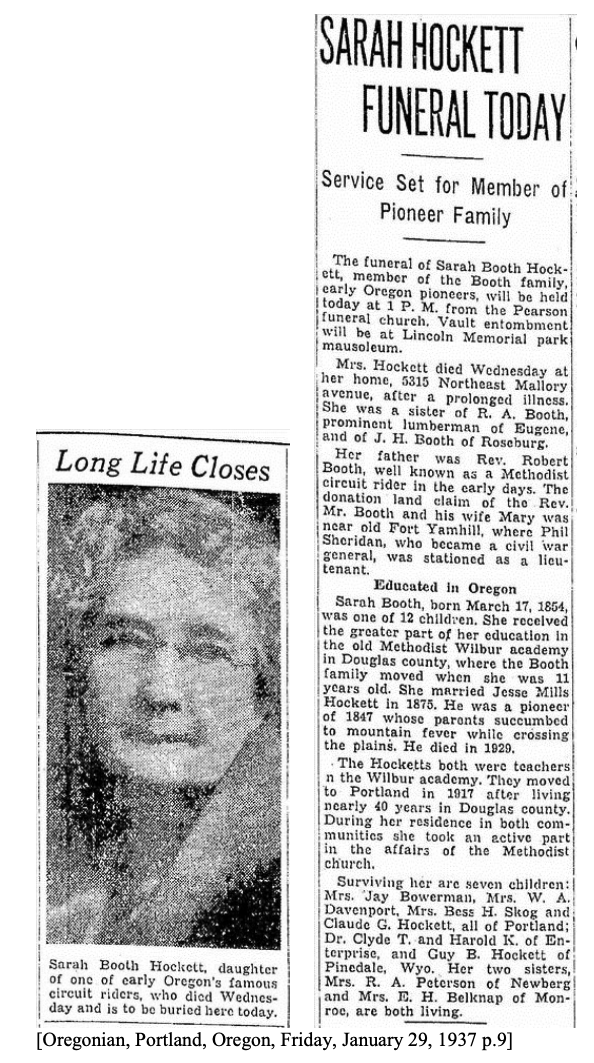
This is the end of this long narrative, however, we need to remember that they lived from the time of Indian Wars to modern times. Theirs was a long, active life full of adventures.
End of Narrative For Jesse and Sarah Hockett
Note: Many of the citations above are available in the full version. All of this will be stored on the Hockett Archive website Permanent.org. If you need access just send a request to R. Hockett.
